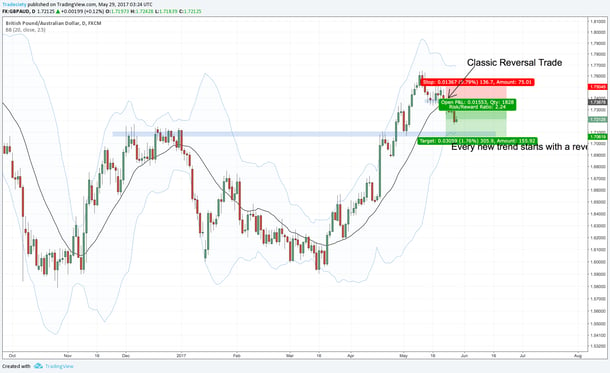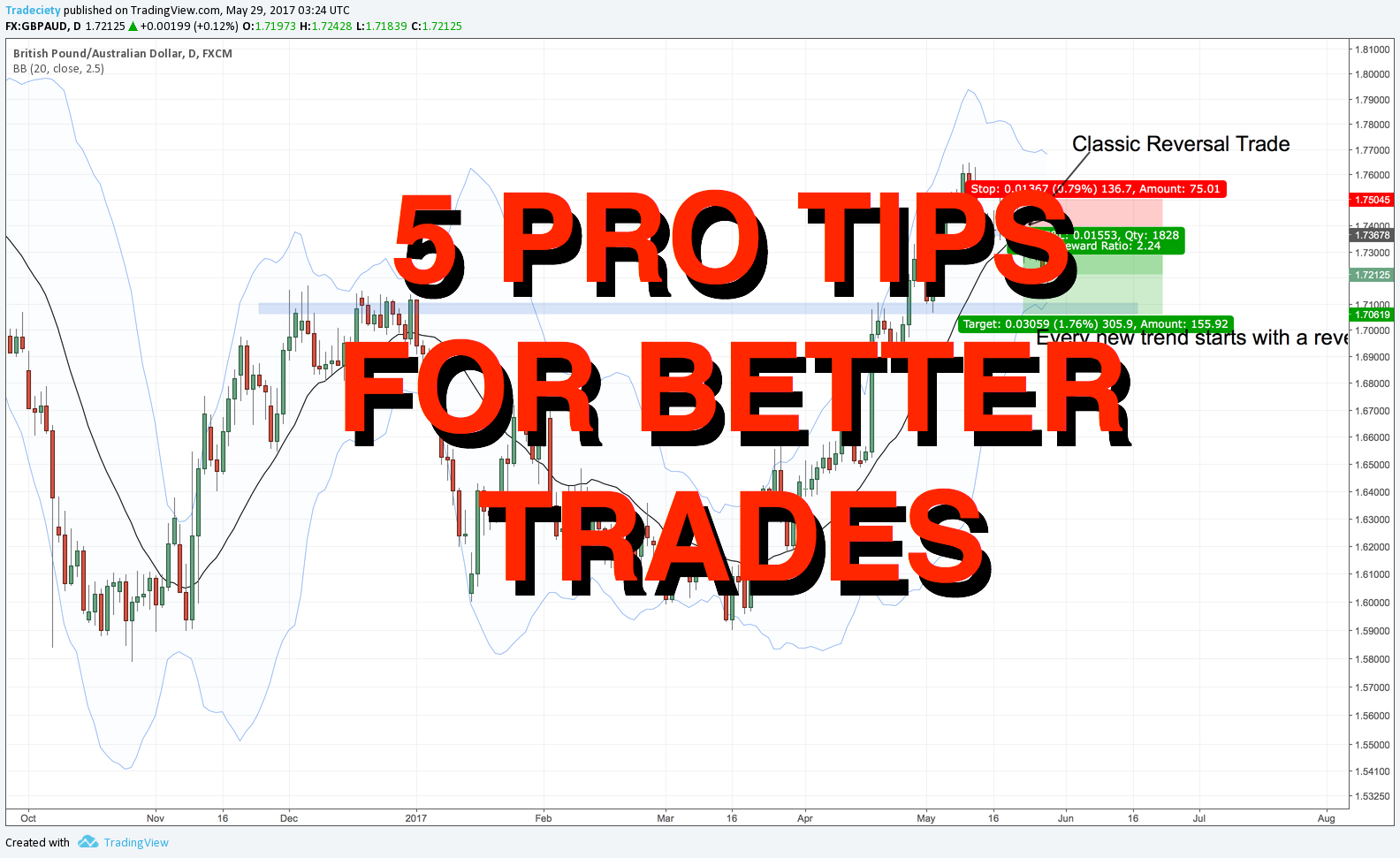3 min read
Scientist Discovered Why Most Traders Lose Money – 24 Surprising Statistics
“95% of all traders fail” is the most commonly used trading related statistic around the internet. But no research paper exists that proves this...
2 weeks ago, I got in the killer USDCAD trade and made over 200 pips. Last week, I got into the GBPAUD short and it’s another great mover. First, let me give you my video where I analyzed the trade and the setup just before it took off:
 This trade is still running and the screenshot shows the current state of the trade. This is one of the many patterns that I trade week after week and you can learn about this in our pro area.
This trade is still running and the screenshot shows the current state of the trade. This is one of the many patterns that I trade week after week and you can learn about this in our pro area.
But I want to take a few moments to give you 5 practical examples that, regardless of your current trading strategy, you can apply right away.
Trading does not (and should not) be that complicated. Although many people say that they want to keep it simple, what they end up doing is, they just strip away all the indicators from their charts and then believe that this is all there is to KISS (Keep it simple stupid).
Wrong! Keeping it simple has nothing to do with how you look at the charts. But it has all to do with your overall approach to the markets and your routine.
So without further ado, here are my 5 top tips to enhance the quality of your trading:
Beginner traders make the mistake of always wanting to trade, all the time. It’s critical to understand that a chart and a market undergoes different phases:
The first step is it, thus, to understand where your system performs best. This is also a good practice that will force the inexperienced and struggling trader to really look at his trading method. I have then observed very often that traders don’t fully understand their system and they don’t know when their system works best. This can be a great revelation IF the trader can then make the next step of becoming aware of market conditions. Ask yourself right now:
Just this simple exercise will help you become more selective and help you gain a better understanding of when you should trade – and when to stay out.
Another rookie mistake I see many people make is that they are too fixed on one timeframe. Many traders ask me “Should I trade the daily, the 4H or the 1H timeframe“? My answer is always: ALL!
As I said in point #1, markets undergo changes all the time. This is why it’s so important to be flexible with your trading. In my own trading, I regularly alternate between the Daily, the 4H and the 1H timeframe. When we have solid trending markets, I will go on the daily and ride the moves there. When momentum drops off a little, I will move to the 4H because the Daily can be too quiet. And when the markets are slowing down even further, I will go to the 1H because a range on the 4H can still be a nice trend on the 1H.
I have a clear process and routine for finding the best timeframe every week.
So to sum up the second point: Don’t be too fixed on just one timeframe. Acknowledge that you either have to sit out more often if you decide to really only trade one timeframe, or start moving around between different timeframes depending on what the market offers.
I get asked “What do you think of this or that chart? Will it go up or down?” and in 90% of all the cases I reply: I don’t know and I don’t care. I don’t say that to be rude or because I don’t want to help, but because I really don’t know.
I am a technical trader. I focus on a few very select patterns and setups. I have clearly defined rules that work during very specific situations. When a market isn’t in a stage where I could get a signal, when a Forex pair is not favoring my style or not close to generating a signal, I don’t care about it. And, more importantly probably, I don’t try to have an opinion all the time.
When you look at my past trades in the forum you’ll see that they all look pretty much identical. And I often say that if you go through your past trades and you notice that they all look very different, you have probably screwed up.
One more benefit is that once you start focusing on one type of setup, you quickly pick up all the little nuances. You will learn what works well ands what doesn’t. What are the signals that make a good setup and when do the setups fail more often!? A trader who follows too many setups (or who doesn’t even have a strategy) will never learn those important things and he can never become a better trader.
Point 3 in a nutshell: Pick your ONE thing (by the way, this is also a great book recommendation), really try to master your one setup and forget about everything else.
There are a few problems with looking at a price chart for too long:
There are probably more than those 3 problems, but they are the biggest performance killers.
The question now is: How do we overcome it?
The answer is simple: Get away from your screen!
Yes, it’s really that simple and you don’t have to make it more complicated than it has to be. In my early days, I always revenge-traded after a loss. What I did then after a losing trade, I closed my computer for a few hours and did something completely different. You’ll lose a lot of the emotional pain that comes with a losing trade once you take your mind off it.
I read the book “The Art Of Learning” which is a MUST READ and the author calls the technique “mental flushing”. It’s super helpful and does work.
These days, I also utilize price alerts a lot. They help me reduce my screen time without missing trades.
Give it a try and you won’t regret it.
I am a reversal trader but lately I started calling myself an “early trend trader” because the word ‘reversal’ is loaded with wrong assumptions.
Every new trend starts with a reversal and reversals often follow the same patterns.
The most important lesson for reversal traders is: don’t call tops and bottoms!
Even as a reversal trader, we have to go WITH the momentum. So when we look at my recent trades from the beginning of this article, you can see that they were both short trades but I never called the absolute top. I always waited for clear confirmation that the previous uptrend was running out of steam and that bears were taking over.
In this context, Jesse Livermore’s quote fits in perfectly:
“One of the most helpful things that anybody can learn is to give up trying to catch the last eighth – or the first. These two are the most expensive eighths in the world. They have cost stock traders, in the aggregate, enough millions of dollars to build a concrete highway across the continent.”
Momentum is key because it usually makes for a much smoother trade. Make sure to check my article about momentum here: Momentum trading guide
But the principle of following momentum goes further than just improving entries. Once you are in a trade, observe momentum and ask:
And so on. Momentum basically means how strong price moves and, obviously, the stronger a move, the more likely it is that it will continue.
So make sure that you are always going WITH momentum and do not fight it.
And that’s it. I now recommend that you sit back for a moment and think about what you have just read.
Then get a notepad out, take some notes and see where you can implement the points in your trading. Don’t change it all at once but make 1 or 2 adjustements, see how it works and then go from there.

3 min read
“95% of all traders fail” is the most commonly used trading related statistic around the internet. But no research paper exists that proves this...

3 min read
Trendlines can be great trading tools if used correctly and in this post, I am going to share three powerful trendline strategies with you.

3 min read
Choosing the right trading journal is essential for traders wanting to analyze performance, refine strategies, and improve consistency. In this...
